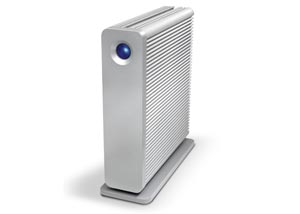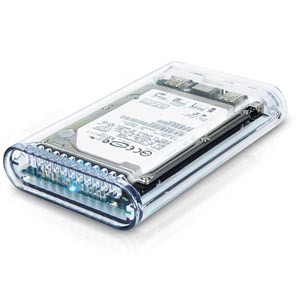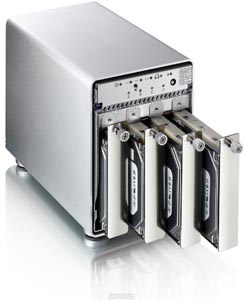Bigger is the New Big: Beefy Hard Drives for Music
On September 1, you’ll have the chance to add the impressive new Native Instruments Komplete 7, with its brand new instruments and effects, to your DAW setup. But ask yourself, what’s harder to come with: the $559 or the 90 GB of hard drive space you’ll need for all audio material?
With all the software and soundware companies out there that are competing for your precious ducats, they’re upping the ante with more and more sounds per purchase. Komplete 7 is an extreme example, but consider MOTU Electric Keys (40GB), Spectrasonics Omnisphere (50GB), or FXpansion BFD2 (55GB).
Then there’s the glut of loop-and-sample companies taking advantage of Web distribution to sell you more audio material for less money. Loopmasters makes excellent stuff and often gives you twice as much downloadable material for half the money of a physical disc. Ever heard of the sample-makers Producer Loops, Zenhiser, Motion Samples, or Tha Loops? There are tons of these outfits popping up. If you’re a virtual instrument and sample junkie, your future is clear… you’re gonna need a bigger drive.
AN EASY GUIDE TO HARD DISKS
Sometimes, simply popping the bestselling hard drive at Amazon.com into your cart and calling it day will be good enough for what you need. But from the perspective of a studio and/or performing musician, it might take some digging to find the combination of storage space, connections and other options from a respected brand. Here are some suggestions for a few types of hard drives from that perspective.
All-Around Good Guy
Everyone’s needs vary, but I picture a common, small studio wanting a high-quality external drive with a variety of computer connections (to accommodate the ever-evolving studio), back-up options and a price that says “I’m not junk, but nor am I diamond-encrusted.” Lastly, anything less than one terabyte (1,000GB) is fit for the retirement home.
With all that in mind, the LaCie d2 Quadra 2TB ($299 MSRP) hits the sweet spot. Personal experience and widespread reputation denote LaCie drives as high-quality and trustworthy both in stability and performance. Nothing is guaranteed of course, so it comes with backup assistant software for both Windows and Mac. It includes an eSATA interface for up to 3GB/second speeds, as well as FireWire 800, FireWire 400 and USB 2.0.
This drive is bootable for both Mac and PC, and its ribbed aluminum sides act as heat sinks to keep the drive cool without noisy fans. For different budgets, there are 1TB ($179) and 1.5TB ($229) models, and there are also d2 Quadra “Enterprise Class” models for a about twice the price that come with high-end disk components, gold-plated contacts, high-end cables and a 5-year warranty.
Road Trip Companion
Laptop performers often want a “mobile” hard drive — one that’s smaller than the average desktop drive and runs off of bus power rather than an AC adapter. Those requirements usually come with the compromises of lower overall capacity, higher price per gigabyte and sometimes slower drive speeds.
To get the most out of a mobile hard drive, I recommend the OWC On-The-Go Pro Triple Interface series. I’ve personally used one for years and it’s still tip-top.
These 11-ounce drives come in a funky clear enclosure and include two FireWire 800 ports and a USB 2.0 port. An included FireWire 800 to 400 cable gives you triple interface compatibility for these Mac/PC drives. They have a power switch and run off of FireWire or USB bus power, but also include a power input for an optional AC adapter.
For the coveted 1TB of storage ($259), you’ll have to accept a drive that runs at 5200 RPM with an 8 MB cache, which may affect the drive’s performance if you’re streaming a lot of high-resolution audio off of it. For the more standard speed of 7200 RPM with a 16 MB cache, the biggest On-The-Go Pro is a 500 GB drive for $147.
Go Big or Go Home
Let’s call this the professionals-only recommendation. You’re working on big projects for clients, so storage capacity and back-up are a must. The Glyph FTRD-8000 ForteRAID is one big mutha with all the connections and flexibility you need. This 8TB assembly is actually four 2TB drives, and the included Glyph Manager 4 software lets you choose various RAID and Spanning modes that offer combinations of speed and automatic back-up security.
Connections include the fastest choice, eSATA, as well as two FireWire 800, one FireWire 400 and USB 2.0, with cables included. For a street price of around $1,800, it’s for serious customers only, but hey… cables included, right?
El Cheapo
From the deluxe apartment in the sky, we go down to the bargain basement. If you just want a terabyte, and that’s all you care about, the Western Digital WD Elements 1 TB model is the Hyundai of hard drives. It comes with a USB 2.0 port, cable, AC adapter and no special features. And yeah, it is the bestselling external drive on Amazon at $74.99 with free shipping.
Future Storage
Now that you’ve got a head full of great suggestions, the pertinent question always remains, “should I buy now, or wait?” The future is always uncertain, but we can all but guarantee that hard drives will be bigger and cost lest per gigabyte in one year (or sooner) than they do now. Not only that, but there are emerging technologies in this space.
While standard for external hard drives is 7200 RPM, there are some internal drives that go to 10,000 and 15,000 RPM. These drives seem to offer diminishing returns of actual performance for their extra cost per gigabyte; and they are limited to smaller capacities as this time, so they aren’t as relevant to this discussion.
Perhaps a more promising technology is the Solid State Drive (SSD). These drives use solid state memory chips with no moving parts for storage rather than electromechanical spinning disks like the hard disk drive (HDD). SSDs promise faster data access time, better durability (especially from physical shock) and quieter performance. However, SSDs aren’t quite ready to usurp HDDs. There are some issues with degradation and performance that need to be ironed out, and they cost several times more per gigabyte than HHDs.
I think SSDs are the future for laptop performers and potentially all storage drives, but there’s no time like the present to upgrade your external drive. Don’t suffer today just to smile tomorrow. — Markkus Rovito
You made it to the end! Congratulations on having all that free time and an attention span longer than that of a caffeinated fruit fly. Your reward: quick links to the Free Sample pages of the aforementioned soundware companies. Some make you start an account before you can grab the freebies.
Loopmasters
Motion Samples
Tha Loops
Zenhiser
Markkus Rovito is a writer, musician, DJ and contributing editor at DJTechTools.com.
Please note: When you buy products through links on this page, we may earn an affiliate commission.









